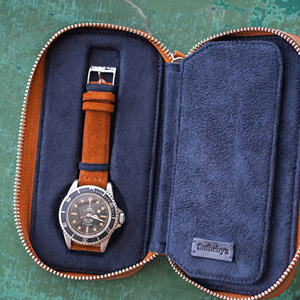
Discrepancies exist as to when and for whom the first wristwatch was created. Some say Abraham Louis-Breguet created the original in 1810 for the Queen of Naples, Caroline Murat. Others credit the Swiss watch company, Patek Philippe, for designing the first to fit the wrist of Countess Koscowicz of Hungary in 1868. Though the beginnings may appear foggy, what is clear is that this timepiece was popularized worldwide in the early 20th century.
Since then, wristwatches have adorned an innumerable sum of people over generations, providing not only a utilitarian facet but also a personal expression of style and character. It’s often considered an essential part of many people’s wardrobes. They literally won’t leave home without wearing some type of timepiece.
That being the case, here are a few tips to keep your prized watch(es) in tip-top shape.
KEEP IT CLEAN
Dirt on a watch isn’t just unsightly, it can be a real danger to its longevity. Small particles of dirt can work their way inside and affect the delicate inner workings of the watch. A soft cloth can be used — microfiber works well — and a little water if necessary to clean the outside.
KEEP IT WOUND
Many watches work on batteries, but if the watch needs to be wound, it’s important to keep it wound and running even if it’s not used every day. Lubricants inside the watch can dry or congeal, but winding helps to keep them spread throughout the watch. This lengthens the life of both the lubricant and the watch itself.
CHANGE STRAPS CAREFULLY
Many a watch owner has inadvertently scratched the lugs (the points on either side of the watch where the strap is attached) when trying to change the strap. What seems like a simple task often ends up being more difficult than it appeared, and the average watch owner doesn’t have the proper tools for the job. Before attempting to do this, it’s important to get some help — either from someone who’s done it before or from instructions and videos online. The tools don’t have to cost a lot, and it’s well worth the investment to avoid scratching or otherwise damaging the watch.
AVOID CONTACT WITH CHEMICALS
Solvents, fuels and paints are clearly to be avoided, and other chemicals, such as perfumes, colognes, cosmetics, creams, detergents and even soap can damage a watch case or strap. If these products are used, the skin should be completely dry before putting on a watch.
KEEP AWAY FROM MAGNETS
Magnets can adversely affect the delicate calibration of a watch and cause an inaccurate keeping of time. Therefore, it is best to keep a watch away from any type of magnet.
STORE WATCHES PROPERLY
Watches should be kept in a dry, dust-free environment. The best place to keep a watch is in its original box. If that isn’t available, it can be stored in another box or container, but multiple watches should be kept separate so they don’t touch one another. Several watches thrown together in the same box will easily get scratched. And a watch shouldn’t be stored face down; this increases the possibility of scratching the crystal.
GET IT SERVICED
While there are no firm rules about how often a watch should be serviced, a good rule of thumb is once every three to five years. Of course, if the watch is running too fast or slow, won’t stay wound, the date won’t change or other functions stop working, it should be serviced right away.



